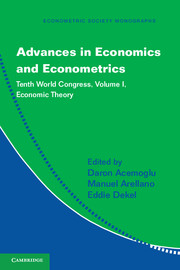Book contents
- Frontmatter
- Contents
- Contributors
- Preface
- I NONSTANDARD MARKETS
- 1 Matching Markets: Theory and Practice
- 2 The Economics of Internet Markets
- 3 Discussion of “Matching Markets: Theory and Practice”
- II CONTRACTS
- III DECISION THEORY
- IV COMMUNICATION/ORGANIZATIONS
- V FOUNDATIONS: EPISTEMICS AND CALIBRATION
- VI PATENTS: PROS AND CONS FOR INNOVATION AND EFFICIENCY
- Name Index
- Miscellaneous Endmatter
3 - Discussion of “Matching Markets: Theory and Practice”
Published online by Cambridge University Press: 05 May 2013
- Frontmatter
- Contents
- Contributors
- Preface
- I NONSTANDARD MARKETS
- 1 Matching Markets: Theory and Practice
- 2 The Economics of Internet Markets
- 3 Discussion of “Matching Markets: Theory and Practice”
- II CONTRACTS
- III DECISION THEORY
- IV COMMUNICATION/ORGANIZATIONS
- V FOUNDATIONS: EPISTEMICS AND CALIBRATION
- VI PATENTS: PROS AND CONS FOR INNOVATION AND EFFICIENCY
- Name Index
- Miscellaneous Endmatter
Summary
Introduction
Market design seeks to offer practical solutions to various resourceallocation problems. Still in its relative infancy, the field already has enjoyed impressive successes in applying economics tools and insights to improve the methods for allocating government resources (e.g., radio spectra) and for organizing professional labor markets such as those for medical interns and residents, assigning students to public schools, and exchanging kidney donors with medical incompatibilities among transplant patients.
An important constraint encountered in many real-world allocation problems is that monetary transfers are limited or unavailable; for instance, public school seats and human kidneys cannot be traded for money. The limitation in the use of monetary transfers means that the classical solution – a competitive market – is excluded from a designer's tool box. A competitive market, or market-inspired mechanisms such as auctions, or a Vickrey-Clarke-Groves (VCG) mechanism are appealing from both efficiency and fairness standpoints. These mechanisms require agents to outbid other contenders for an object that he or she desires; the object then will go to the agent willing to pay the most – typically, one who values it most. Thus, the resulting allocation is efficient. It is also fair in the sense that the objects valued more by the agents are priced higher, requiring higher payment for those wishing to claim them. For instance, the VCG mechanism requires an agent to pay precisely the social-opportunity cost of his or her assignment.
- Type
- Chapter
- Information
- Advances in Economics and EconometricsTenth World Congress, pp. 76 - 86Publisher: Cambridge University PressPrint publication year: 2013

